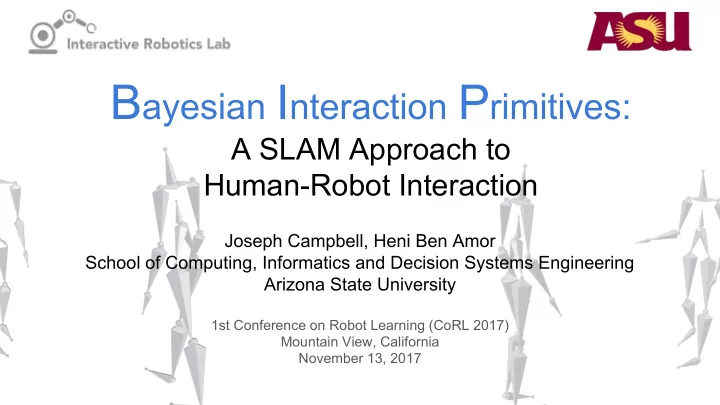

B ayesian I nteraction P rimitives: A SLAM Approach to Human-Robot Interaction Joseph Campbell, Heni Ben Amor School of Computing, Informatics and Decision Systems Engineering Arizona State University 1st Conference on Robot Learning (CoRL 2017) Mountain View, California November 13, 2017
Human-Robot Interaction ● Programming HRI is hard! ● Represent interaction in time & space ● Generalize over interaction partners Robot Learning ● Learning from demonstration ● Multimodal/high-dimensional ● Robust in time & space 1
Interaction Primitives H. Ben Amor, G. Neumann, S. Kamthe, O. Kroemer, J. Peters. Interaction primitives for human-robot cooperation tasks. ICRA, 2014. 2 G. Maeda, M. Ewerton, R. Lioutikov, H.Ben Amor, J. Peters, G. Neumann. Learning interaction for collaborative tasks with probabilistic movement primitives. Humanoids, 2014.
Problem: Temporal Alignment Dynamic Time Warp ● Poor performance in higher dimensions ● Not probabilistic ● Does not leverage spatial inference ● Difficult to use recursively 3
Simultaneous Localization and Mapping Insight: “Localize in time, generate action in space” ● Probabilistic reasoning over time ● Action generation in space ● Phase = location ● Weights = map 4
Bayesian Interaction Primitives Extended Kalman Filter SLAM applied to Interaction Primitives Time Space 5
Experiments 6
Results Spatial robustness Temporal robustness 7
Results cont. Partial visibility Computational complexity 8
Applications 9
Conclusions ● Established conceptual link between HRI and SLAM ● Bayesian Interaction Primitives from demonstrations ● Properties: ○ Improved robustness to noise ○ Reduced computational complexity ○ Fully Bayesian inference in time and space ● Applied to multiple, physical human-robot collaboration tasks Future work: ● Highly multimodal scenarios ● Noise-resilient SLAM algorithms 10
Acknowledgements Thank you to all Hosoda Lab members at Osaka University, especially Prof. Koh Hosoda Assist. Prof. Shuhei Ikemoto
Recommend
More recommend